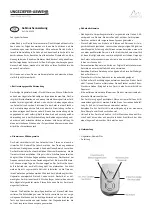
rhdf2dl1sm-rev0413
Model RHDF2 Page 27
AirVantage Servicing - Sensor Assembly
To service the control module, first shut off and bleed the air being supplied to the pump. For safety
purposes the air supply line should be disconnected from the pump. Then shut off the suction and discharge
lines to the pump. Bleed the pressure from the pump suction and discharge lines and remove the lines from
the pump. During the servicing of the AirVantage, consult the “AirVantage Composite Repair Parts Drawing”.
(page 23)
Step #1: Remove the Patch Cable
• Twist the ribbed portion of the patch cable connector in a counterclockwise direction, until it unthreads
from the connector. The cable can either be removed from the intermediate or from the control module.
Step #2: Remove the AirVantage from the Pump
• Use a ½” socket and remove the four 5/16-18 x 5
½
cap screws that hold the AirVantage to the pump.
Be sure to support the weight of the AirVantage while removing the last cap screw. After the AirVantage
is removed from the pump, set the unit down on the plastic cover located on the bottom. Inspect the
o-ring between the poppet valve and the adapter plate for damage.
Step #3: Diaphragm Disassembly
• Refer to the “Diaphragm Servicing” section (p.15) of the manual to remove diaphragm assembly from
the pump.
•
“airVantage caution” – When the diaphragm assembly is removed, watch for the brass probe
tips located on the end of the sensor rod. there is one brass probe tip and one o-ring per side.
inspect the probe tips and o-rings for wear. for every diaphragm service, these parts should be
replaced and are available in kit form. consult the “composite repair Parts Drawing” for part
numbers and quantities.
Step #4: Accessing the Actuator Plunger Bushings and O-rings
• The actuator plunger pin bushings and o-rings can now be accessed. If it is determined that these parts
need to be replaced, use a small screwdriver and remove the retaining rings.
•
note: it is recommended that new retaining rings be installed after disassembly.
The bushing
and o-ring can now be removed and inspected.
Step #5: Accessing the AirVantage Sensor
• If the sensor needs to be replaced, use a 13/16” socket and remove the plastic nut securing the
connector to the intermediate. Slide the connector out of the hole, taking care not to lose/misplace the
gasket on the connector.
• The sensor can now be removed from the intermediate assembly.
Step #6: Reinstallation
• Slide the new sensor assembly in the intermediate.
• “AirVantage CAUTION” – Make sure the cable assembly fits into the groove machined in the
intermediate. failure to do so may damage the cable during assembly.
• Feed the connector through the hole in the intermediate and install the plastic nut. Hand tighten the nut
using a 13/16" socket. Make sure the gasket is to the inside of the intermediate.
• The inner chambers and gaskets can now be reinstalled. Use blue thread locker on the inner chamber
bolts and torque them to 300 in-lbs.
• Refer to the “Diaphragm Servicing” section of the manual to finish the diaphragm installation procedure.
Note:
Refer to Composite Repair Parts List on
page 12 for part numbers
Page 17
PROBE TIP
O-RING
SENSOR, FEED BACK
WASHER, SEALING
PLATE, DIAPHRAGM
DIAPHRAGM
PAD, WEAR
PLATE,
OUTER DIAPHRAGM
CAPSCREW
SENSOR COVER
CAPSCREW
END CAP
FEED BACK SENSOR
O-RING
CAPSCREW
INTERMEDIATE
JAM NUT
O-RING
FOAM BUMPER
BEARING
SEAL
A
BRACKET, INTERMEDIATE, ASSEMBLY
SENSOR, FEEDBACK
NUT
SEAL
DIAPHRAGM
PLATE,
OUTER DIAPHRAGM
PLATE,
INNER DIAPHRAGM
PROBE TIP
O-RING
SENSOR, FEEDBACK
BUMPER
DETAIL A
FLAT EDGE








































